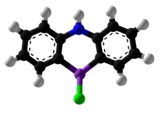Adamsite
 |
|||
|
|
|||
| Names | |||
|---|---|---|---|
|
Systematic IUPAC name
10-Chloro-5,10-dihydrophenarsazinine
|
|||
| Other names
10-Chloro-5H-phenarsazinine
Diphenylaminechlorarsine |
|||
| Identifiers | |||
|
3D model (Jmol)
|
|||
| Abbreviations | DM | ||
| ChemSpider | |||
| ECHA InfoCard | 100.008.577 | ||
| EC Number | 209-433-1 | ||
| MeSH | Phenarsazine+chloride | ||
|
PubChem CID
|
|||
|
|||
|
|||
| Properties | |||
| C12H9AsClN | |||
| Molar mass | 277.58 g·mol−1 | ||
| Appearance | Yellow-green crystals | ||
| Melting point | 195 °C (383 °F; 468 K) | ||
| Boiling point | 410 °C (770 °F; 683 K) | ||
| 0.064 g dm−3 | |||
|
Except where otherwise noted, data are given for materials in their standard state (at 25 °C [77 °F], 100 kPa).
|
|||
|
|
|||
| Infobox references | |||
Adamsite or DM is an organic compound; technically, an arsenical diphenylaminechlorarsine, that can be used as a riot control agent. DM belongs to the group of chemical warfare agents known as vomiting agents or sneeze gases. First synthesized in Germany by Heinrich Otto Wieland in 1915, it was independently developed by the US chemist Roger Adams (for whom it is named) at the University of Illinois in 1918.
DM was produced and stockpiled by the British and the United States at the end of World War I. It was used by the British during the incursions at Murmansk and Archangel. In the US, it was used against the Bonus Army who demonstrated in Washington, DC, in 1932, reportedly causing the death and serious injury of several children who had accompanied their parents on the protests. It was again used in the Vietnam War.
DM is an odourless crystalline compound with a very low vapour pressure. The colour of the crystals ranges from bright yellow to dark green depending on the purity. It is readily soluble in some organic solvents (e.g., acetone, dichloromethane), but nearly insoluble in water. In vaporous form it appears as a canary yellow smoke.
Adamsite is usually dispersed as an aerosol, making the upper respiratory tract the primary site of action. Although the effects are similar to those caused by typical riot control agents (e.g. CS), they are slower in onset but longer in duration, often lasting for 12 or more hours. After a latency period of 5–10 minutes irritation of the eyes, lungs and mucous membranes develops followed by headache, nausea and persistent vomiting.
...
Wikipedia


